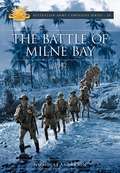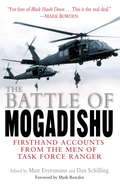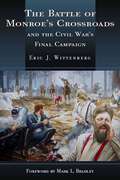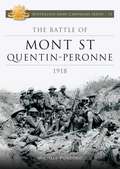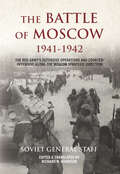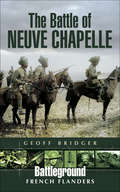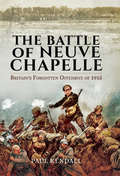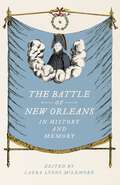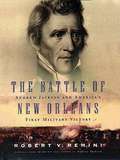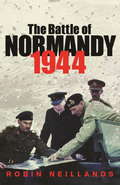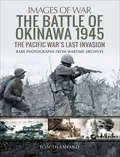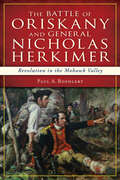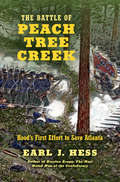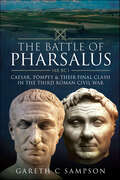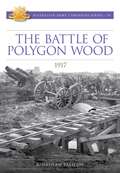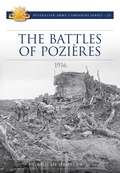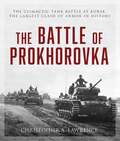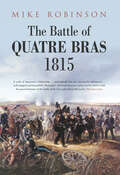- Table View
- List View
The Battle of Milne Bay 1942 (Australian Army Campaigns Series #24)
by Nicholas AndersonBy 1942 the formidable Japanese military had conquered swathes of territory across south-east Asia and the Pacific Ocean. Despite its defeat at the Battle of Midway, Japan remained a potent enemy committed to the creation of a defensive arc to shield its captured possessions in the Pacific. The capture of Port Moresby would cement the southern border of this defensive arc and sever the vital lines of communication between Australia and the United States. It was the Japanese plan to seize Moresby that would set the course for the Battle of Milne Bay. Situated on the eastern tip of New Guinea, Milne Bay was a wretched hell-hole: swamp-riddled, a haven for malaria and cursed with torrential rain. It was here that General Douglas MacArthur ordered the secret construction of an Allied base with airfields to protect the maritime approach to Port Moresby. But the Japanese soon discovered the base at Milne Bay and despatched a task force to destroy its garrison and occupy the base. All that stood between the Japanese and their prize was a brigade of regular Australian soldiers untrained in tropical warfare and a brigade of Australian militia with no combat experience whatsoever. While the Kokoda campaign is etched in public memory, its sister battle at Milne Bay has long been neglected. However the bitter fighting over this isolated harbour played an equally important role in protecting Port Moresby and made a valuable contribution to shifting Allied fortunes in the Pacific War.
The Battle of Mogadishu: First Hand Accounts From the Men of Task Force Ranger
by Matt Eversmann Dan SchillingIt started as a mission to capture a Somali warlord. It turned into a disastrous urban firefight and death-defying rescue operation that shocked the world and rattled a great nation. Now the 1993 battle for Mogadishu, Somalia–the incident that was the basis of the book and film Black Hawk Down–is remembered by the men who fought and survived it. Six of the best in our military recall their brutal experiences and brave contributions in these never-before-published, first-person accounts. “Operation Gothic Serpent,” by Matt Eversmann: As a “chalk” leader, Eversmann was part of the first group of Rangers to “fast rope” from the Black Hawk helicopters. It was his chalk that suffered the first casualty of the battle. “Sua Sponte: Of Their Own Accord,” by Raleigh Cash: Responsible for controlling and directing fire support for the platoon, Cash entered the raging battle in the ground convoy sent to rescue his besieged brothers in arms. “Through My Eyes,” by Mike Kurth: One of only two African Americans in the battle, Kurth confronted his buddies’ deaths, realizing that “the only people whom I had let get anywhere near me since I was a child were gone.” “What Was Left Behind,” by John Belman: He roped into the biggest firefight of the battle and considers some of the mistakes that were made, such as using Black Hawk helicopters to provide sniper cover. “Be Careful What You Wish For,” by Tim Wilkinson: He was one of the Air Force pararescuemen or PJs–the highly trained specialists for whom “That Others May Live” is no catchphrase but a credo–and sums up his incomprehensible courage as “just holding up my end of the deal on a bad day.” "On Friendship and Firefights,” by Dan Schilling: As a combat controller, he was one of the original planners for the deployment of SOF forces to Mogadishu in the spring of 1993. During the battle, he survived the initial assault and carnage of the vehicle convoys only to return to the city to rescue his two closest friends, becoming, literally, “Last Out.” With America’s withdrawal from Somalia an oft-cited incitement to Osama bin Laden, it is imperative to revisit this seminal military mission and learn its lessons from the men who were there and, amazingly, are still here today.
The Battle of Monroe's Crossroads: The Civil War's Last Campaign
by Eric J. WittenbergThe Battle of Monroe's Crossroads, fought March 10, 1865, was one of most important but least known engagements of William T. Sherman's Carolinas Campaign. Confederate cavalry, led by Lt. Gen. Wade Hampton and Maj. Gen. Joseph Wheeler, launched a savage surprise attack on the sleeping camp of Maj. Gen. Judson Kilpatrick, Sherman's cavalry chief. After three hours of some of the toughest cavalry fighting of the entire Civil War, Hampton broke off and withdrew. His attack, however, had stopped Kilpatrick's advance and bought another precious day for Lt. Gen. William J. Hardee to evacuate his command from Fayetteville. This, in turn, permitted Hardee to join the command of Gen. Joseph E. Johnston and set the stage for the climactic Battle of Bentonville nine days later. Noted Civil War author Eric Wittenberg has written the first detailed tactical narrative of this important but long-forgotten battle, and places it in its proper context within the entire campaign. His study features 28 original maps and 50 illustrations. Finally, an author of renown has brought to vivid life this overlooked portion of the Carolinas Campaign. Ohio Attorney Eric J. Wittenberg is a noted Civil War cavalry historian and the author of some dozen books and two dozens articles on the Civil War. His first book, "Gettysburg's Forgotten Cavalry Actions," won the 1998 Bachelder-Coddington Literary Award.
The Battle of Mont St Quentin Peronne 1918: The Battle of Mont St Quentin-Peronne 1918 (Australian Army Campaigns #11)
by Michele BomfordThe Battle of Mont St Quentin-Peronne 1918 explores the relationship between myth and history and the significance of the Anzac legend. It analyses the forces that drove the diggers forward even when they had reached the limits of their endurance. The Battle of Mont St Quentin-Peronne represents the Australian Corps at its very best, its diggers fighting for peace and satisfied that, `whatever might lie ahead, at least everything was right behind them'.
The Battle of Moscow 1941–1942: The Red Army’s Defensive Operations and Counter-offensive Along the Moscow Strategic Direction
by Soviet General Staff"The Battle of Moscow, 1941–1942: The Red Army’s Defensive Operations and Counteroffensive Along the Moscow Strategic Direction" is a detailed examination of one of the major turning points of World War II, as seen from the Soviet side. The Battle of Moscow marked the climax of Hitler’s “Operation Barbarossa,” which sought to destroy the Soviet Union in a single campaign and ensure German hegemony in Europe. The failure to do so condemned Germany to a prolonged war it could not win. This work originally appeared in 1943, under the title "Razgrom Nemetskikh Voisk pod Moskvoi" (The Rout of the German Forces Around Moscow). The work was produced by the Red Army General Staff’s military-historical section, which was charged with collecting and analyzing the war’s experience and disseminating it to the army’s higher echelons. This was a collective effort, featuring many different contributors, with Marshal Boris Mikhailovich Shaposhnikov, former chief of the Red Army General Staff and then head of the General Staff Academy, serving as general editor. The book is divided into three parts, each dealing with a specific phase of the battle. The first traces the Western Front’s defensive operations along the Moscow direction during Army Group Center’s final push toward the capital in November–December, 1941. The study pays particular attention to the Red Army’s resistance to the Germans’ attempts to outflank Moscow from the north. Equally important were the defensive operations to the south of Moscow, where the Germans sought to push forward their other encircling flank. The second part deals with the first phase of the Red Army’s counteroffensive, which was aimed at pushing back the German pincers and removing the immediate threat to Moscow. Here the Soviets were able to throw the Germans back and flatten both salients, particularly in the south, where they were able to make deep inroads into the enemy front to the west and northwest. The final section examines the further development of the counteroffensive until the end of January 1942. This section highlights the Soviet advance all along the front and their determined but unsuccessful attempts to cut off the Germans’ Rzhev–Vyaz’ma salient. It is from this point that the front essentially stabilized, after which events shifted to the south. This new translation into English makes available to a wider readership this valuable study.
The Battle of Neuve Chapelle (Battleground French Flanders)
by Geoff BridgerA history of the World War I engagement between British and German forces in northern France, and a visitor’s guide to the battlefield site.Neuve Chapelle, a lost battlefield, is now opened up for the explorer to learn more about the actions that took place there.In early 1915, the British decided to take the offensive for the first time in the war against German positions in Northern France. The initial objective was a bulge, about one mile across, in their lines at Neuve.Events which took place here early in 1915 are described in detail and show why this almost forgotten battle set the course of the war.
The Battle of Neuve Chapelle: Britain's Forgotten Offensive Of 1915
by Paul KendallNeuve Chapelle a lost battlefield is now opened up for the explorer to learn more about the actions that took place there.In Early 1915, the British decided to take the offensive for the first time in the war against German positions in Northern France. The initial objective was a bulge, about one mile across, in their lines at Neuve.Events which took place here early in 1915 are described in detail and show why this almost forgotten battle set the course of the war.
The Battle of New Orleans in History and Memory
by Laura Lyons MclemoreThe Battle of New Orleans proved a critical victory for the United States, a young nation defending its nascent borders, but over the past two hundred years, myths have obscured the facts about the conflict. In The Battle of New Orleans in History and Memory, distinguished experts in military, social, art, and music history sift the real from the remembered, illuminating the battle's lasting significance across multiple disciplines. Laura Lyons McLemore sets the stage by reviewing the origins of the War of 1812, followed by essays that explore how history and memory intermingle. Donald R. Hickey examines leading myths found in the collective memory--some, embellishments originating with actual participants, and others invented out of whole cloth. Other essayists focus on specific figures: Mark R. Cheathem explores how Andrew Jackson's sensational reputation derived from contemporary anecdotes and was perpetuated by respected historians, and Leslie Gregory Gruesbeck considers the role visual imagery played in popular perception and public memory of battle hero Jackson. Other contributors unpack the broad social and historical significance of the battle, from Gene Allen Smith's analysis of black participation in the War of 1812 and the subsequent worsening of American racial relations, to Blake Dunnavent's examination of leadership lessons from the war that can benefit the U.S. military today. Paul Gelpi makes the case that the Creole Battalion d'Orleans became protectors of American liberty in the course of defending New Orleans from the British. Examining the European context, Alexander Mikaberidze shows that America's second conflict with Britain was more complex than many realize or remember. Joseph F. Stoltz III illustrates how commemorations of the battle, from memorials to schoolbooks, were employed over the years to promote various civic and social goals. Finally, Tracey E. W. Laird analyzes variations of the tune "The Battle of New Orleans," revealing how it has come to epitomize the battle in the collective memory.
The Battle of New Orleans: Andrew Jackson and America's First Military Victory
by Robert V. ReminiThe Battle of New Orleans was the climactic battle of America's "forgotten war" of 1812. Andrew Jackson led his ragtag corps of soldiers against 8,000 disciplined invading British regulars in a battle that delivered the British a humiliating military defeat. The victory solidified America's independence and marked the beginning of Jackson's rise to national prominence. Hailed as "terrifically readable" by the Chicago Sun Times, The Battle of New Orleans is popular American history at its best, bringing to life a landmark battle that helped define the character of the United States.
The Battle of Normandy 1944
by Robin NeillandsA fresh and incisive examination of one of the Second World War's crucial campaigns, the battle for Normandy in the months after D-Day.What happened to the Allied armies in Normandy in the months after D-Day, 1944? Why, after the initial success of the landings, did their advance stall a few miles inland from the beaches? Why did the British take so long to capture Caen? Why did the US infantry struggle so much in the bocage south of Omaha beach? Who was right about the conduct of the land campaign - Eisenhower or Montgomery? How did the Germans, deprived of air support, manage to hold off such a massive Allied force for more than two months? And if Enigma was allowing the Allies to read German battleplans, why did things go wrong as often as they did?THE BATTLE OF NORMANDY re-examines the demands and difficulties of the campaign and sheds new light on both with the aid of accounts from veterans on both sides. (Oral history forms a large part of the book.) It also analyses in detail the plans and performance of the commanders involved: Eisenhower, Bradley, Patton, Montgomery, Crerar and, of course, Rommel. Controversial and at times catastrophic, the Battle of Normandy was the last great set-piece battle in history and is long overdue for reassessment.
The Battle of Normandy 1944: 1944 The Final Verdict (Sven Hassel War Classics)
by Robin NeillandsA fresh and incisive examination of one of the Second World War's crucial campaigns, the battle for Normandy in the months after D-Day.What happened to the Allied armies in Normandy in the months after D-Day, 1944? Why, after the initial success of the landings, did their advance stall a few miles inland from the beaches? Why did the British take so long to capture Caen? Why did the US infantry struggle so much in the bocage south of Omaha beach? Who was right about the conduct of the land campaign - Eisenhower or Montgomery? How did the Germans, deprived of air support, manage to hold off such a massive Allied force for more than two months? And if Enigma was allowing the Allies to read German battleplans, why did things go wrong as often as they did?THE BATTLE OF NORMANDY re-examines the demands and difficulties of the campaign and sheds new light on both with the aid of accounts from veterans on both sides. (Oral history forms a large part of the book.) It also analyses in detail the plans and performance of the commanders involved: Eisenhower, Bradley, Patton, Montgomery, Crerar and, of course, Rommel. Controversial and at times catastrophic, the Battle of Normandy was the last great set-piece battle in history and is long overdue for reassessment.
The Battle of North Cape: The Death Ride of the Scharnhorst, 1943 (Campaign Chronicles)
by Angus Konstam Christopher Summerville“The hunting down and sinking of the magnificent German battle cruiser Scharnhorst was one of the epic actions of World War II . . . stirring” (Work Boat). On December 25, 1943, the German battle cruiser Scharnhorst slipped out of Altenfjord in Norway to attack Arctic convoy JW55B which was carrying vital war supplies to the Soviet Union. But British naval intelligence knew of the Scharnhorst’s mission before she sailed, and the vulnerable convoy was protected by a large Royal Naval force including the battleship Duke of York. In effect the Scharnhorst was sailing into a trap. One of the most compelling naval dramas of the Second World War had begun. “Angus Konstam’s gripping account tells the story of this crucial but under-studied naval battle, and explains why the hopes of the German Kreigsmarine went down with their last great ship; only 37 of the German battle cruiser’s 1700 crew were saved.” —The Nautical Magazine “Angus Konstam has written the definitive masterpiece of the Battle of North Cape.” —Naval Historical Foundation “An excellent read and strongly recommended . . . thoughtful and totally engrossing. . . . If you are interested in the Royal Navy in the Second World War, the Arctic convoy campaign or capital ship actions, The Battle of the North Cape is well worth its cover price.” —The Naval Review
The Battle of Okinawa 1945: The Pacific War's Last Invasion (Images of War)
by Jon Diamond Dr.A pictorial history of one of World War II&’s most bitterly fought campaigns. The American campaign to capture Okinawa, codename Operation Iceberg, was fought from April 1 to June 22, 1945. Three hundred and fifty miles from Japan, Okinawa was intended to be the staging area for the Allied invasion of the Japanese mainland. The Japanese Thirty-second Army defenders were on land and the Imperial Navy at sea fought tenaciously. They faced the US Tenth Army, comprising the US Army XXIV Corps and the US Marines&’ III Amphibious Corps. As this superb book reveals in words and pictures, this was one of the most bitterly fought and costly campaigns of the Second World War. Ground troops faced an enemy whose vocabulary did not include &“surrender,&” and at sea the US Fifth Fleet, supported by elements of the Royal Navy, had to contend with kamikaze attacks by air and over seven hundred explosive-laden suicide boats. The Okinawa campaign is synonymous with American courage and determination to defeat a formidably ruthless enemy.
The Battle of Oriskany and General Nicholas Herkimer: Revolution in the Mohawk Valley (Military Ser.)
by Paul A BoehlertA gripping account of events before, during, and after this British defeat in New York&’s Mohawk Valley, and the man who led the Continental army to victory. During the critical Battle of Oriskany in August 1777, Continental forces led by General Nicholas Herkimer defeated the British army under St. Leger in the heart of New York&’s Mohawk Valley. It was a hard-won victory, but he and his brave troops prevented the British from splitting the colonies in two. Although they did not succeed in relieving the British siege of Fort Stanwix, Herkimer&’s citizen-soldiers turned back the British and protected Washington&’s northern flank from attack. The Continental army survived to fight the decisive Battle of Saratoga the next month. Herkimer was mortally wounded, but his heroism and leadership firmly placed him in the pantheon of Revolutionary War heroes. Paul Boehlert presents a gripping account of the events before, during and after this critical battle. Includes photos and illustrations
The Battle of Peach Tree Creek: Hood's First Effort to Save Atlanta (Civil War America)
by Earl J. HessOn July 20, 1864, the Civil War struggle for Atlanta reached a pivotal moment. As William T. Sherman's Union forces came ever nearer the city, the defending Confederate Army of Tennessee replaced its commanding general, removing Joseph E. Johnston and elevating John Bell Hood. This decision stunned and demoralized Confederate troops just when Hood was compelled to take the offensive against the approaching Federals. Attacking northward from Atlanta's defenses, Hood's men struck George H. Thomas's Army of the Cumberland just after it crossed Peach Tree Creek on July 20. Initially taken by surprise, the Federals fought back with spirit and nullified all the advantages the Confederates first enjoyed. As a result, the Federals achieved a remarkable defensive victory. Offering new and definitive interpretations of the battle's place within the Atlanta campaign, Earl J. Hess describes how several Confederate regiments and brigades made a pretense of advancing but then stopped partway to the objective and took cover for the rest of the afternoon on July 20. Hess shows that morale played an unusually important role in determining the outcome at Peach Tree Creek--a soured mood among the Confederates and overwhelming confidence among the Federals spelled disaster for one side and victory for the other.
The Battle of Pharsalus (48 BC): Caesar, Pompey & Their Final Clash in the Third Roman Civil War
by Gareth C. SampsonIn August 48 BC, following the earlier battle at Dyrrhachium, the two greatest Roman commanders of their generation met in battle again at Pharsalus in Greece. Julius Caesar, conqueror of Gaul, had been defeated at Dyrrhachium and forced to retreat but now stood at bay to face Pompey the Great, conqueror of the East. At stake lay the future of the ailing Roman Republic, each man believing he alone had the solution to restoring Republican government. Gareth Sampson examines the campaigns which led up to the battle as well as the role played by the various regional powers who got drawn into the Roman Civil War. The Battle of Pharsalus itself is analyzed in detail to determine the strengths and weakness of both armies and their various commanders, as well as the organization, equipment and tactics of the forces involved in the battle which culminated in a decisive victory for Caesar. The author concludes with consideration of the aftermath of the battle, which saw Pompey murdered in Egypt and Caesar distracted by the affairs of the East.
The Battle of Polygon Wood 1917 (Australian Army Campaigns #19)
by Jonathan PasslowBuoyed by the success of the 1st and 2nd Australian divisions in the Battle of Menin Road, the men of the 4th and 5th Australian divisions filed into the front line ready for the next phase of the battle. Ahead of them lay the blackened remnants of Polygon Wood, a desolate expanse of splintered stumps shattered by the devastating shellfire. The view across no man’s land revealed lines of German barbed wire and a criss-cross of heavily defended trenches. Here and there the Australians could also see solid concrete pillboxes dotted around the landscape. In the centre of the battlefield sat a huge man-made mound of earth — the Butte. Once the stop-butte for an old artillery range, this dominating feature was fortified with machine-guns, laced with barbed wire and riddled with tunnels and dugouts. The Battle of Polygon Wood was the second phase in the British forces’ advance on Passchendaele. Success at Polygon Wood would place Broodseinde Ridge within the Second Army’s reach. But the entire operation was almost blindsided by a German counter-attack on the eve of the battle. The critical situation on the Anzac Corps right was only saved by Pompey Elliott’s 15th Brigade whose desperate efforts to contain the German attack and seize the Second Army’s objectives turned a ‘fine success’ into a ‘splendid victory’. But, as author Jonathan Passlow describes in Polygon Wood 1917, this was a victory that was by no means assured and in which luck would play its part.
The Battle of Pozieres 1916 (Australian Army Campaigns #22)
by Meleah HamptonThe Battle of Pozières has reverberated throughout Australia’s military history, long regarded as a costly battle that produced little meaningful gain. Pozières was characterised by the most intense artillery bombardment the Australians had experienced in the war thus far and ‘the hell that was Pozières’ became the yardstick by which subsequent bombardments were measured. The 13th Battalion’s Frank Massey described men who became ‘blithering idiots … Crying and weeping and — absolutely useless as a fighting man.’ The object of the battle was Pozières Ridge, a low rise that offered a good view of the German positions. Heavily fortified, the ridge and the pulverised remains of the village were contested bitterly and, during its six-week campaign, 1st Anzac Corps advanced little more than two miles and suffered 23,000 casualties. Charles Bean wrote that ‘Australian troops … fell more thickly on this ridge than on any other battlefield of the war.’ However, the first phase of the campaign was very successful, securing the fortified ruins of Pozières and the German second line. But follow-up operations failed to capitalise and subsequent assaults merely nibbled away at enemy positions without making significant headway. Yet the Battle of Pozières marks a significant achievement not only for 1st Anzac Corps, but for the British Expeditionary Force. In a war in which any advance was hard won, the wresting of the high ground from the Germans was crucial. For the battered Allied forces, the capture of Pozières Ridge provided faint hope of an end to a catastrophic war.
The Battle of Prokhorovka: The Climactic Tank Battle at Kursk, the Largest Clash of Armor in History
by Christopher A. LawrenceThe Battle of Kursk was one of the defining moments of World War II. In July 1943, German forces under Erich von Manstein--one of Germany&’s best generals--launched a massive attack in an offensive code-named Citadel. A week later, the Soviets counterattacked, sparking a huge clash of tanks at Prokhorovka, the largest armor battle in history, pitting more than 600 Soviet tanks against some 300 German panzers. Though the Germans gained a tactical victory, destroying huge numbers of Soviet tanks, they failed to achieve their objectives, and in the end the battle marked a turning point on the Eastern Front. The Red Army gained the strategic initiative and would not lose it.
The Battle of Quatre Bras 1815
by Mike RobinsonMajor Richard Llewellyn, who fought at Quatre Bras, wrote in 1837 that, 'Had it not been so closely followed by the... victory of Waterloo, perhaps the gallant exploits and unexampled bravery that marked that day would... have excited even more admiration than was actually associated with it.'This book stands out from the wealth of Napoleonic literature in that it is the first English-language account to focus solely on the battle of Quatre Bras. It is based upon extensive research and in many cases unpublished personal accounts from all participating countries, as well as a detailed topographic, aerial survey of the battlefield. These combine to provide a highly personal, balanced and authoritative work. The author unravels the controversies of a battle where commanders made errors of omission and commission and where cowardice rubbed shoulders with heroism. This is the story of a battle that turned a campaign; of triumph and disaster. It is a story of two great generals, but more importantly, of the intense human experience of those that they led. It is a book that will appeal to both the scholar and the generalist.
The Battle of Quiberon Bay, 1759: Hawke and the Defeat of the French Invasion
by Nicholas TracyRevered naval theorist, Alfred Thayer Mahan, thought the Battle of Quiberon Bay (20 Nov 1759) was as significant as Nelson's victory in 1805, calling it 'the Trafalgar of this war [the Seven Years War]'. Arguably it was even more vital. Britain in 1759 was much less well-defended, with virtually no regular troops at home, and the threat of French invasion was both more realistic and more imminent. When the British fleet under Admiral Hawke fell upon them, the French ships of the line under Admiral Conflans were actually on their way to rendezvous with the invasion troopships gathered at the mouth of the Loire. Yet the battle and the admiral remain relatively obscure—there is no Quiberon Square or Hawke's column. The battle itself was fought in terrible weather, the French attempting to exploit their local knowledge by heading for Quiberon Bay, assuming the British would not follow them among its treacherous shoals in such conditions. Hawke, however, pursued them under full sail and the French ships were destroyed, captured, run aground or scattered for the loss of only two British ships which ran aground. The invasion was thwarted. Professor Nicholas Tracy studies the battle and its strategic consequences, particularly upon the war for North America.
The Battle of Salamis: The Naval Encounter That Saved Greece and Western Civilization
by Barry StraussOn a late September day in 480 B.C., Greek warships faced an invading Persian armada in the narrow Salamis Straits in the most important naval battle of the ancient world. Overwhelmingly outnumbered by the enemy, the Greeks triumphed through a combination of strategy and deception. More than two millennia after it occurred, the clash between the Greeks and Persians at Salamis remains one of the most tactically brilliant battles ever fought. The Greek victory changed the course of western history -- halting the advance of the Persian Empire and setting the stage for the Golden Age of Athens. In this dramatic new narrative account, historian and classicist Barry Strauss brings this landmark battle to life. He introduces us to the unforgettable characters whose decisions altered history: Themistocles, Athens' great leader (and admiral of its fleet), who devised the ingenious strategy that effectively destroyed the Persian navy in one day; Xerxes, the Persian king who fought bravely but who ultimately did not understand the sea; Aeschylus, the playwright who served in the battle and later wrote about it; and Artemisia, the only woman commander known from antiquity, who turned defeat into personal triumph. Filled with the sights, sounds, and scent of battle, The Battle of Salamis is a stirring work of history.
The Battle of Savo
by Stanley E. SmithNight of Confusion…Down the “Slot”—that fabled channel between chains of islands in the Solomon group—steamed the task force of Admiral Gunichi Mikawa, Japanese Imperial Navy.His target: the Allied cruiser group gathered off Savo Island, near Guadalcanal.Three thousand Japanese guns were pointed at the destroyer Blue, on interception duty at the head of the Allied column. But no one aboard Blue noticed the enemy force churning past—so Blue roused no enemy fire.Not so lucky were the cruisers Quincy, Vincennes, Canberra and Astoria. This exciting factual book details the incredible confusion and horror that made the Battle of Savo a low point in American naval history.An American Naval TragedySo shocking was the defeat of American naval forces by the Japanese in Savo Sound, that the American public could not accept the true story until ten years afterward.On Guadalcanal, Marines were moving up the rugged Tenaru River country, ranging for battle and depending on the Navy for cover.On board the flagship McCawley, Admiral Turner was begging for carrier-based air support that never came.On the flag bridge of his heavy cruiser, Chokai, Admiral Gunichi Mikawa signalled the torpedo fire that opened “The Battle of Savo”.
The Battle of Sekigahara: The Greatest, Bloodiest, Most Decisive Samurai Battle Ever
by Chris GlennSekigahara was the greatest samurai battle in history. Japan had long been at civil war until brought under the rule of Oda Nobunaga, and then, following his death at the hands of a traitorous general, that of Toyotomi Hideyoshi. It was Hideyoshi who completed the unification of Japan and ushered in a period of peace. After Hideyoshi’s death in 1598, a power struggle emerged between those loyal to the Toyotomi, and those who supported the second most powerful warlord, Tokugawa Ieyasu. With Hideyoshi gone, Ieyasu made moves that brought the ire of a number of his contemporaries, and soon the entire country was divided into two great armies, East and West. Leading the loyalist cause was Ishida Mitsunari, who gathered a force of around 130,000 samurai, while the Tokugawa commanded just 80,000. Both sides hurried to seize strategically vital highways and castles. These attacks and sieges culminated in the decisive Battle of Sekigahara. Fought on 21 October 1600, the battle lasted just six hours, but saw the deaths of an estimated 30,000 samurai, the destruction of a number of noble families and the creation of the Tokugawa Shogunate that was to rule Japan for 260 years of relative peace. The loyalist forces, despite their superior numbers and excellent battle formations, were defeated. In his exploration of the battle, Chris Glenn reveals the developments that led up to the outbreak of war, the characters involved, how the battle itself unfolded, and the aftermath. The weapons and armor of the time are also fully explained, along with little known customs of the samurai and their warfare.
The Battle of South Mountain (Civil War Series)
by John David Koptak&“A thorough account of the fighting . . . Not only appealingly written but a worthwhile addition to Maryland Campaign literature.&” —Historynet.com In September 1862, Robert E. Lee led the Army of Northern Virginia north of the Potomac River for the time as part of his Northern invasion, seeking a quick end to the war. Lee divided his army in three, sending General James Longstreet north to Hagerstown and Stonewall Jackson south to Harper&’s Ferry. It was at three mountain passes, referred to as South Mountain, that Lee&’s army met the Federal forces commanded by General George B. McClellan on September 14. In a fierce day-long battle spread out across miles of rugged, mountainous terrain, McClellan defeated Lee but the Confederates did tie up the Federals long enough to allow Jackson&’s conquest of Harper&’s Ferry. Join historian John Hoptak as he narrates the critical Battle of South Mountain, long overshadowed by the Battle of Antietam. &“A remarkable work . . . The marches of both armies to South Mountain are presented with close attention to the men in the ranks. The combat is fully covered at each of the gaps in South Mountain.&” —Civil War Librarian &“A crisp, concise but comprehensive account of the battles at the four passes or &‘gaps&’ across South Mountain on September 14, 1862 . . . A truly scholarly effort that will satisfy both serious Civil War students and the general reading public. For Maryland Campaign aficionados, it is a must have addition to your library and is now the definitive account of the battle.&” —South from the North Woods
